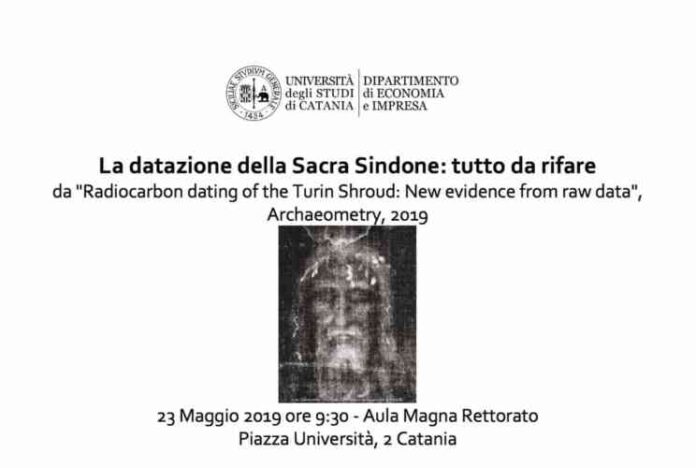CATANIA – Giovedì 23 maggio l’Università di Catania ospiterà un importante evento in cui verranno presentati risultati su alcune interessanti conclusioni riguardanti la datazione della Sacra Sindone.
Non ci sono prove conclusive che la Sindone sia medievale. Nel 1988 fu effettuata una datazione radiocarbonica della Sindone, da molti ritenuta il lenzuolo funebre di Gesù. Il risultato pubblicato sulla rivista Nature fu chiaro: la Sindone è medievale (1260-1390 d. C.). Fino ad ora, questa conclusione era stata ritenuta dalla maggior parte degli scienziati come una confutazione dell’autenticità del telo. Dall’incontro multidisciplinare tra sindonologi (Emanuela Marinelli e Tristan Casabianca), statistici (Benedetto Torrisi dell’Università di Catania) e data analyst (Giuseppe Pernagallo) nasce una nuova analisi, basata sui dati ufficiali e i dati grezzi (pubblicati per la prima volta in una rivista scientifica), e nuove conclusioni che dimostrano come la tesi pubblicata su Nature non era affidabile.
“La nostra analisi – afferma Benedetto Torrisi – prova che non c’è evidenza definitiva che la Sindone sia medievale” ed oggi tale assunzione trova spazio e riconoscimento scientifico su Archaeometry, rivista edita per conto dell’Oxford Research Laboratory for Archaeology and the History of Art.
Sin dalla pubblicazione dell’articolo su Nature, molti ricercatori hanno richiesto, invano, la pubblicazione dei dati grezzi dei tre laboratori (Oxford, Arizona, Zurigo). Tuttavia, i laboratori e il British Museum (l’Istituzione incaricata dell’analisi statistica) hanno sempre eluso la richiesta. Nel 2017, per la prima volta, uno dei ricercatori del nostro team, il francese Tristan Casabianca, ha richiesto tramite Freedom of Information Act al British Museum tali dati, riuscendo ad ottenere i report inviati dai tre laboratori all’Istituzione.
Già in passato, tra il 1988 e il 2019, altri contributi avevano messo in discussione i risultati pubblicati su Nature. Ma la questione principale ruotava attorno ai dati grezzi, che sino ad ora erano rimasti segretati, oggi in possesso dei ricercatori dell’Università di Catania grazie al coinvolgimento della Marinelli e di Casabianca.
“Aver ottenuto i dati grezzi – continua Torrisi – ha permesso di formulare diverse considerazioni: i laboratori hanno prodotto risultati differenti, non riconducibili allo stesso fenomeno. Qualcosa è andato storto durante il processo di datazione, probabilmente poiché i campioni testati non erano omogenei. Questa conclusione statistica è avvalorata dal fatto che i laboratori hanno menzionato la presenza di materiale eterogeneo non menzionato nell’articolo su Nature, quale antico cotone o fili blu e rossi. La documentazione rilasciata dal British Museum dipinge un quadro molto più complesso di quanto presentato nell’articolo su Nature. Le scoperte del team di ricerca evidenziano che le procedure (selezionate dopo più di 10 anni di negoziazioni tra archeologi, esperti di tessuti e Santa Sede) sono state ben lontane dalla perfezione”.
La visione proposta in questo nuovo articolo è molto più sottile: quando lo strumento d’indagine è la rigorosa analisi scientifica, le conclusioni passate, seppur scientifiche, possono e devono essere messe sempre in dubbio, anche dopo trent’anni.
Ecco perché è stato necessario organizzare una tavola rotonda come appuntamento di approfondimento sulle assunzioni, sulle conclusioni, sulle visioni e sulle proposte per futuri scenari di ricerca, con la presenza del prof. Marco Riani (ordinario di Statistica dell’Università di Parma), del prof. Bruno Barberis (sssociato di Fisica Matematica presso il fipartimento di Matematica dell’Università di Torino) del prof. Paolo Di Lazzaro (Fisico e Dirigente di ricerca ENEA, Centro Ricerche Frascati e bice direttore del CISS – Centro Internazionale di Studi sulla Sindone di Torino) insieme agli autori della ricerca Benedetto Torrisi, Tristan Casabianca, Emanuela Marinelli e Giuseppe Pernagallo.
L’incontro sarà aperto dal rettore dell’Università di Catania Francesco Basile, dal sindaco Salvo Pogliese e dal direttore del dipartimento di Economia ed Impresa prof.ssa Michela Cavallaro.
La Sindone fu definita il “Vangelo del XX secolo”, e sicuramente sarà anche il “Vangelo del XXI secolo”. Come affermò San Giovanni Paolo II, la Sindone è “una sfida alla nostra intelligenza”. Appuntamento al 23 maggio nell’aula magna del Rettorato dell’Università di Catania, alle 9,30. Statistici, storici della Sindone, fisici, matematici e sindonologi discuteranno risultati che riaprono la discussione sulla datazione della Sacra Sindone.
English version
The University of Catania will host an important event regarding the discussion of results already known all over the world thanks to the work of its researchers and their conclusions on the radiocarbon dating of the Turin Shroud. There is no conclusive evidence that the Turin Shroud is medieval. In 1988, a radiocarbon analysis of this linen cloth thought by many to be the burial cloth of Jesus of Nazareth was performed. The results published in Nature were clear: the Shroud is medieval (AD 1260-1390). Until now, this conclusion was considered by most of scientists as a disproof of the claims of authenticity. The multidisciplinary work of sindonologists (Emanuela Marinelli and Tristan Casabianca), statisticians (Benedetto Torrisi) and data analysts (Giuseppe Pernagallo) a new statistical analysis, based on official and raw data published for the first time in an academic journal, shows that the conclusion published in Nature is not reliable.
Benedetto Torrisi asserts that “our analysis proves that there is no conclusive evidence that the Turin Shroud is medieval” and today this claim is scientifically recognized thanks to the fact that the paper was accepted in an Oxford peer-reviewed journal, Archaeometry, published on behalf of the Oxford Research Laboratory for Archaeology and the History of Art.
Since the Nature article, many scientists asked in vain for the release of the raw data. However, the three laboratories (Oxford, Arizona, Zürich) and the British Museum, the centralizing institution in charge of the statistical analysis, never favorably answered to this request. In 2017, for the first time, a member of this research team, French researcher Tristan Casabianca, made a legal request (Freedom of Information Act) to the British Museum and obtained the reports sent by the three laboratories to the institution.
Since 1988, many doubts were raised by other works against the conclusion of this famous radiocarbon dating. But the main question remained the raw data, never released, now those data were obtained by the researchers of the University of Catania thanks to Emanuela Marinelli and Tristan Casabianca.
Torrisi says that “obtaining the raw data, consented us to make several considerations”: the results for both the official and raw data strongly suggest that the laboratories produced significant different results. Something went wrong during the radiocarbon process, probably because the tested samples were not homogenous. This statistical conclusion is also supported by the fact that the laboratories mentioned the presence of foreign material not reported in Nature, such as old cotton or blue and read threads. The documentation released by the British Museum depicts a much more complex picture than what was presented in the Nature article. These findings illustrate the point that the procedure (chosen after more than ten years of negotiations between archaeologists, textile experts and the Holy See) was far from perfect.Nessuno può affermare con certezza che la Sindone abbia origini medioevali, eppure la datazione della Sindone fu divulgata come trionfo della scienza sulla religione. Una nuova datazione è quindi necessaria, ma dovrebbe essere inserita in un vero processo interdisciplinare.
No one can seriously affirm that the Turin Shroud is without a doubt of medieval origin. albeit the dating of the Turin Shroud was presented as the triumph of science over religion. A new radiocarbon testing is mandatory, but it must be included in a true interdisciplinary process.
The picture offered by this new discovery is a much more subtle one: even in this emblematic case study, scientific conclusions can and should always be put into question, even 30 years later. From this consideration, the need to organize an event where future scenarios of research can be discussed thanks to the presence of Prof. Marco Riani (Full Professor of Statistics, University of Parma), Prof. Bruno Barberis (Associate Professor of Mathematical Physics, Department of Maths, University of Turin), Prof. Paolo Di Lazzaro (Physicist and Executive of the research center ENEA, Frascati e Deputy Director of CISS – Centro Internazionale di Studi sulla Sindone di Torino), of the authors of the research Benedetto Torrisi, Tristan Casabilanca, Emanuela Marinelli e Giuseppe Pernagallo, of the Rector of Unict Prof. Francesco Basile, of the Mayor of Catania Dr. Salvo Pogliese and of the Director of the Department of Economics and Business of Unict, Prof. Michela Cavallaro.
The Shroud of Turin was often described as a “Gospel for the 20th century”. Now, there is little doubt that this controversial cloth will also be a “Gospel for the 21st century”. As asserted by St John Paul II, the Shroud of Turin remains “a challenge to our intelligence”.
We will wait for you on 23 May 2019, at Aula Magna Rettorato dell’Università di Catania, 9:30, where Statisticians, Historians, Physicists, Mathematicians and Sindonologists will discuss results that open again the discussion on the Radiocrabon Dating of the Turins Shroud.




































